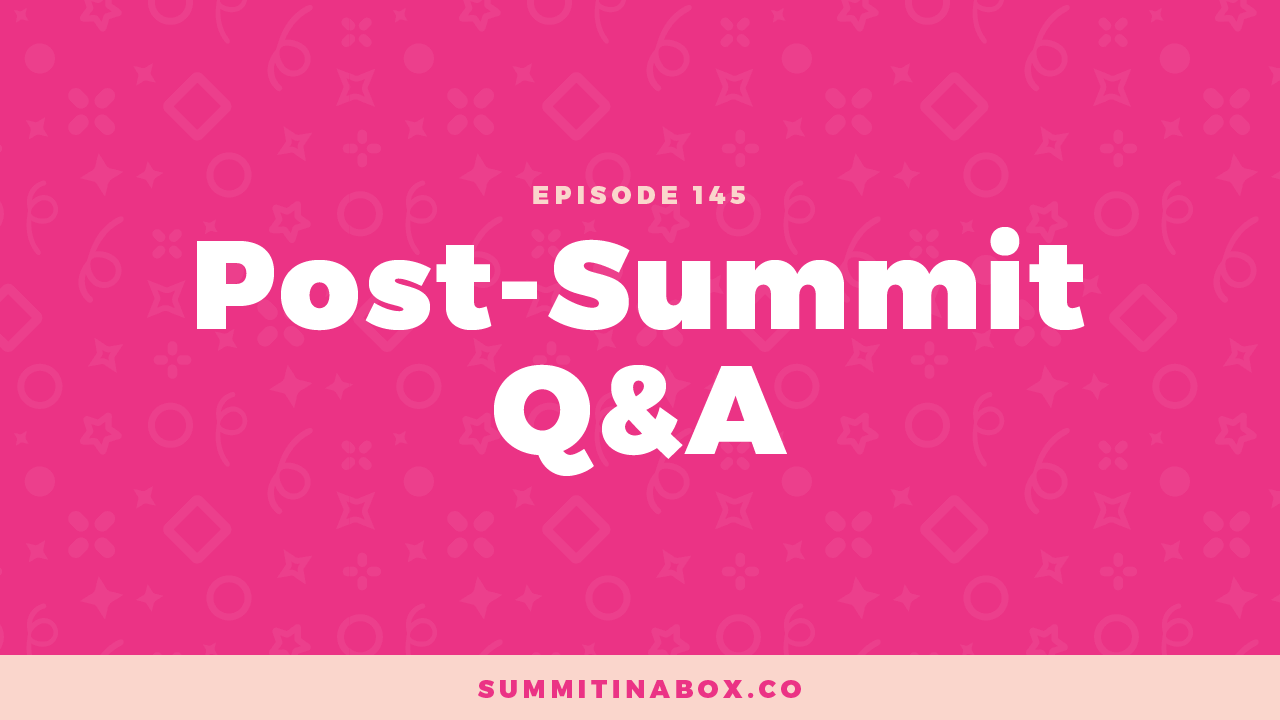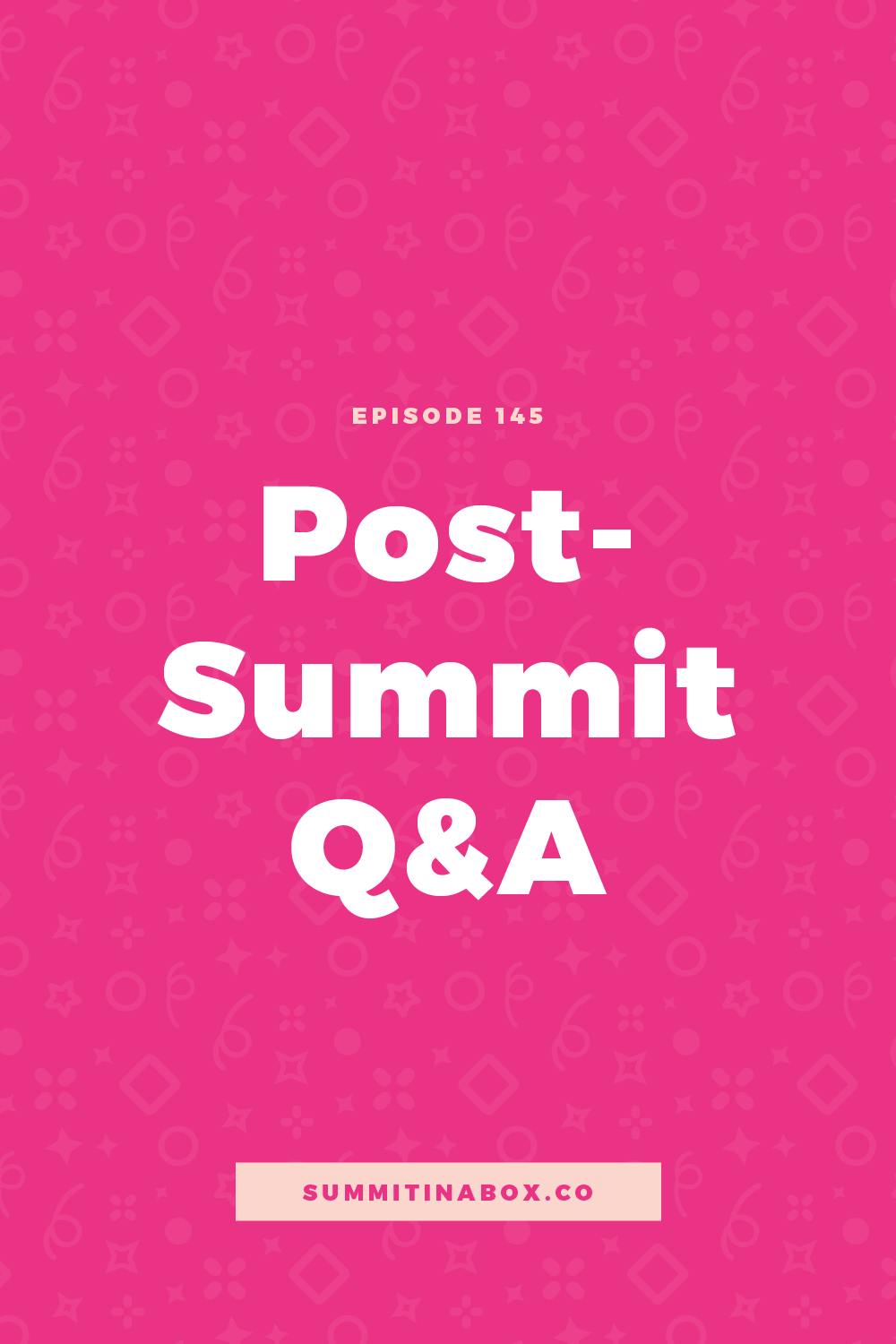Post-Summit Q&A


You hosted a great summit, but now you're left with a few questions about what to do next.
This week, I've got answers to some of the most common post-summit questions.
We’ll cover things like:
- how many emails to send once your summit is over
- what to have on the website
- how long to wait before hosting another summit
- and more!
Post-Summit Questions
How many emails do you send after the summit to promote the all-access pass?
The days following the summit are perfect for doing a final push of your all-access pass. The number of emails to send is a personal preference and depends on a few things:
- How long do you want to keep the all-access pass available?
- Are you selling something else after your summit that you'd rather focus on?
- What are your personal selling preferences?
As an example, I close the cart to my all-access pass 3 days after my summit ends. My summit ends on a Friday, and the cart closes on Monday.
Throughout that time, I send these 4 emails:
- Friday afternoon - An email that celebrates the summit, shares the biggest takeaways, and reminds attendees to watch the closing call. It lets attendees know that presentations are available until the following morning and briefly mentions the all-access pass at the end.
- Saturday morning – An email to help attendees put everything they learned into action and remind them that the all-access pass is available to refer back to as they implement.
- Monday – Two last chance cart close emails, one in the morning and one in the evening.
What should I have on my summit website after the summit is over?
After the summit ends, it's important to provide some sort of direction for people who will still come across your registration page.
There are two options that work well here:
- The evergreen version of your registration page - Your summit’s site would look like it does when your summit is live and people could still sign up and go through the content.
- A waitlist page - A simple page that allows people who are interested to sign up to be notified when registration opens for the next round.
What should a waitlist page include?
Overall, your summit's waitlist page can be fairly simple. I like to include:
- A quick message that the summit is over and that they can sign up to be notified about the next round.
- A sign-up form that feeds into your email marketing platform.
- A mention of where they can access the replays if you're selling the recordings.
After someone joins the waitlist you can redirect them to a sales page for the presentation replays if you have them available.
From there, you can either send an email sequence that continues to encourage the purchase of the replays, enter them into another funnel you have, add them to your regular email list, or simply let them be on the waitlist without receiving additional emails.
Once the summit is over, how do I keep profits up? Do you sell other items? Host more summits?
This is all up to you and your business model, but here are a few options.
We covered what to do with your attendees after your summit in this post. If you have an offer, sharing it with attendees is the best way to increase profit once the summit is over. Keep in mind that anyone who doesn't buy in an initial launch will continue to gain interest and may buy in the future. You can see even better results by making targeted offers based on what you know about attendees.
For example, as of writing this, I’m about 9 months out from a summit about summits and I had some of those attendees decide to join my program in my most recent launch. It’s still paying off almost a year later.
If you don't have an offer to sell, take what you learned about attendees at your summit and use it to influence new offers you create.
And, of course, you can continue to host more summits.
After my summit is done, how quickly can I do another one?
This depends on a few things, including:
- How often it sounds fun to you.
- Whether your event changes themes each time (meaning you can get away with doing it more often) or stays the same.
- The time you and your team have to put into it.
Personally, one to two summits per year is where I like to keep it.
However, I have a student in Summit in a Box® who uses summits as her primary way to make money through her business. She hosts a summit quarterly, planning the next summit as she’s wrapping up her current one and each summit has a new theme, which keeps it exciting for her audience.
What questions do you ask in a post-summit feedback form?
To start, consider what you want to know from attendees after your summit is over and ask those questions.
To share some examples, I want to know things like:
- What presentations and speakers were your favorite and why?
- What new topics do you want to learn about next time?
- Who would you like to see as a speaker?
- What were your favorite parts of the event?
- What would you like to see changed?
Questions like these are helpful during speaker outreach because you can refer to specific things attendees were asking for in your pitch.
And keeping attendee feedback in mind for your next round will help you make each event better and better. I've gotten great feedback over the years and it has shaped the way I do summits.
Make your Post-Summit Plan
If you have a summit coming up, take a few minutes to think through what the post-summit period will look like. Think through your emails, what you'll have on your website, what you'll do with attendees, and when the next round might happen.



